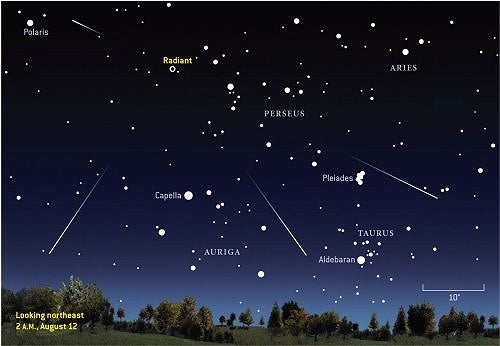August 4, 2004
The annual Perseid meteor shower is typically one of the best of the year. And in 2004, the shower occurs in a relatively moonless sky. This is a real plus for those who want to see more meteors and not just the very bright ones. Bright, fast meteors — many leaving glowing trails visible for several seconds — characterize the Perseid meteor shower.
The annual Perseid meteor shower is typically one of the best of the year. And in 2004, the shower occurs in a relatively moonless sky. This is a real plus for those who want to see more meteors and not just the very bright ones. Bright, fast meteors — many leaving glowing trails visible for several seconds — characterize the Perseid meteor shower.
The best time to see “the tears of St. Lawrence” in the United States will be Wednesday night, August 11, into the dark morning hours of August 12. The Moon doesn’t rise until after 2 A.M. local daylight time and will appear only 12-percent lit.
Some astronomers predict a sharp peak in activity this year at 21h UT on August 11. Unfortunately, this time corresponds to 3 P.M. EDT — daylight for North and South America. Still, observers in these locations may see increased shower rates during the morning hours of August 11 and 12.
The Perseids were given that name because if you trace all the meteor trails backward, they meet within the boundaries of the constellation Perseus the Hero who, in Greek mythology, slew the Gorgon Medusa.
The Perseid meteor shower is caused by Comet Swift-Tuttle, which was discovered in 1862. Comet Swift-Tuttle returned to the inner solar system in 1992. As it swung around the Sun, it added to its particle stream.











